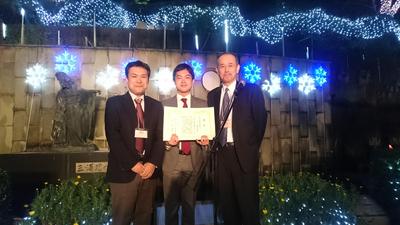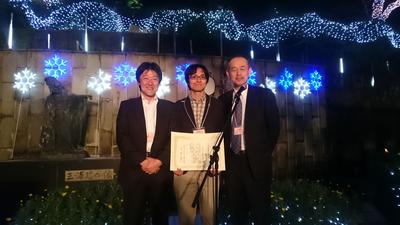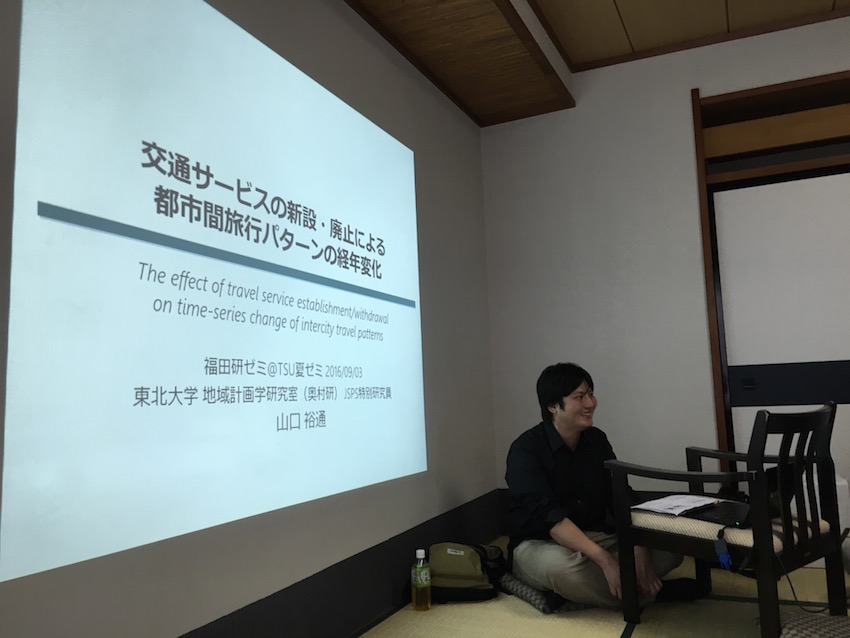Preparation of the JSCE conference (June 9-10, Tokyo Tech Ookayama Campus)
The 57th Annual Conference on Japan Society of Civil Engineers (JSCE) will be held on June 9-10, 2012, at Tokyo Tech Ookayama Campus. A team of faculty members and students in the fields of civil engineering and landscape and design engineering at Tokyo Tech will be in charge of organizing the conference. Everyone is encouraged to participate it!
Two new papers on para-transit in Asian cities
Two papers on para-transit in Asian cities (We newly call it “LAMAT – Locally Adopted and Modified Advancecd Transport”) have been published in Journal of EASTS (Eastern Asia Society for Transportation Studies):
- By Hong Tan VAN, Daisuke FUKUDA
- Journal of the Eastern Asia Society for Transportation Studies, Volume 12 (2017) 2284-2298, Released: April 25, 2018
- doi={https://doi.org/10.11175/easts.12.2284}
- https://www.jstage.jst.go.jp/article/easts/12/0/12_2284/_article/-char/en
- This paper discusses the determinants of the intention to shift to a new high-quality Locally Adapted, Modified, and Advanced Transport (LAMAT) bus service in Ho Chi Minh City using a stated preference (SP) survey. Mixed logit models (MXL) are used to estimate the mode choice between motorcycles (MCs) and LAMAT in the SP choices. The use of a panel-MXL is shown to significantly improve the estimation results compared with the standard multinomial logit model. Accordingly, heterogeneity in the LAMAT choice is largely explained by citizens’ unobserved characteristics, whereas their preference for time and money might be homogenous. Additionally, four mode-specific factors, i.e., provision of information, air conditioning, seat availability (LAMAT), and the risk of traffic accidents (MCs) are found to be significant determinants of the intention to use the LAMAT bus service.
- By Daisuke FUKUDA, Hana KOBAYASHI, Wataru NAKANISHI, Yoshiki SUGA, Kerkritt SRIROONGVIKRAI, Kasem CHOOCHARUKUL
- Journal of the Eastern Asia Society for Transportation Studies, Volume 12 (2017) 2151-2169, Released: April 25, 2018
- DOI https://doi.org/10.11175/easts.12.2151
- https://www.jstage.jst.go.jp/article/easts/12/0/12_2151/_article/-char/en
- The objective of this study is to investigate the applicability of Wi-Fi monitoring technology to the estimation of the boarding and alighting locations of paratransit passengers via a small-scale field test that was conducted in Krabi City, Thailand. From the results, we determined that: (1) with use of appropriate data cleaning procedures, many of the noisy data could be eliminated to a reasonable degree; (2) it would be reasonable to ignore Wi-Fi data for which the moving distances are too short, and regard them as outliers or irrelevant records; (3) when the proposed matching methods are used with the ground truth data, suitable numbers of the Wi-Fi data are well matched.
Introduction to the Paper (Journal of Japan Society of Civil Engineers)
A paper on “Travel Time Reliability,” which has been conducted in our laboratory for many years, has been published. This is a joint research with Prof. Yasuo Asakura’s group.
- Fukuda, Daisuke & MIZUGUCHI, Masanori & Seo, Toru & Kusakabe, Takahiko & ASAKURA, Yasuo. (2017). EVALUATION OF AREA LEVEL TRAVEL TIME RELIABILITY USING LARGE-SCALE PROBE VEHICLE TRAJECTORIES RECORDED FOR A LONG PERIOD. Journal of Japan Society of Civil Engineers, Ser. D3 (Infrastructure Planning and Management). 73. I_1105-I_1118. (Link to the Paper)
Travel time reliability has been basically evaluated in terms of “line” units such as links, routes, and lines. In contrast, against the background of the rapid accumulation of probe information in recent years, this research proposed a method to calculate travel time reliability indices at the area level using statistical values of total travel distance and total travel time obtained by aggregating vehicle travel trajectory data in an arbitrary time-space domain (e.g., in “area” units). This enables, for instance, the evaluation of the time reliability performance of the road network of an administrative region, and the impact analysis for areal measures (area inflow charges), external shocks (e.g., snowfall), and etc.
Introduction to the Paper (Journal of the City Planning Institute of Japan)
[November 2017]
The paper is published in the Journal of the City Planning Institute of Japan [Volume 52 (2017) Issue 3], and the following research by doctoral student, Mr. Dantsuji, has been published.
Below is a brief report from Mr. Dantsuji.
A research paper on understanding the characteristics of tourist circulation behavior using Wi-Fi packet sensors, conducted as part of activities related to the “urban development of the Hasedera Monzenmachi neighborhood” in collaboration with the Institute of Urban and Regional Studies, Waseda University since July 2016, has been published in the Journal of the City Planning Institute of Japan. The research was conducted in collaboration with Professor Emeritus Mitsuyuki Asano, an advisor to the Institute of Urban and Regional Studies of Waseda University, and Yoshitatsu Sugishita, a second-year doctoral student in the Asakura Laboratory. We are grateful for the cooperation of the people in Sakurai City, Nara Prefecture, and of the Institute of Urban and Regional Studies, Waseda University, including Professor Shigeru Sato and Research Fellow Hajime Ohki. We would like to express our deepest gratitude to them.
Dantsuji
**************************************************
Analysis of the Properties of Tourists’ Dwell Time using Wi-Fi Packet Data: A Case Study of the Approach to Hase-dera Temple
Takao Dantsuji, Kashin Sugishita, Daisuke Fukuda, Mitsuyuki Asano
Understanding tourist behavior in sightseeing areas is quite important to consider policy measures. Traditionally, the questionnaire survey has been conducted to analyze the tourist behavior. However, due to high cost and the heterogeneity of the sample, such survey has been gradually limited. This study analyzes the tourist behavior using Wi-Fi scanner which captures the probe request from electronic devices such as smartphones, which is an alternative way to the questionnaire survey due to the much lower cost. We take Hase area where Hase-dera Temple is located as a case study and it is found that the dwell time of the tourists who accessed with different transportation modes to Hase area is clearly different, that is, the dwell time of the tourist who take trains is longer than that of the tourists who drive. Moreover, the difference property of dwell time between the tourists at the morning and afternoon can be found.
Mr. Ge received the BinN Research Award @ 16th Annual Behavioral Model Summer School 2017
[September 13, 2017].
Research Associate, Mr. Ge gave a presentation titled “Reservoir-based Surrogate Modeling of Dynamic Traffic Assignment” at the 16th Behavioral Modeling Summer School 2017 workshop and received the BinN research Award. The research aimed to reduce the computational load by performing the user equilibrium allocation on a macroscopic (area-based) rather than a link-based (microscopic) basis.
Reference WebPage: The University of Tokyo, Hato Lab (Twitter).
A new research paper on urban rail passenger demand forecasting in Tokyo
A research paper on the Tokyo Metropolitan Area rail demand forecasting model used in the April 2016 Ministry of Land, Infrastructure, Transport and Tourism Transport Policy Council report, “Future Urban Railways in the Tokyo Area“, has been accepted for publication in the international journal “Transportation Research Record” (The conference paper can be viewed here). This is the result of several years of discussion and analysis with Prof. Iwakura of Shibaura Institute of Technology, Prof. Kato of the University of Tokyo, Mr. Ito of the Japan Transport and Tourism Research Institute, and members of Shakai Systems Co. We would like to express our deepest gratitude to everyone involved.
———————————————————————
Latest Urban Rail Demand Forecast Model System in the Tokyo Metropolitan Area
By Hironori Kato, Daisuke Fukuda, Yoshihisa Yamashita, Seiji Iwakura and Tetsuo Yai
This paper reports on an urban rail travel demand forecast model system, which technically supported the formulation of the Tokyo Urban Rail Development Master-plan 2016. The model system was included in the forthcoming 15-year urban rail investment strategy for Tokyo. The model system was utilized to quantitatively assess urban rail projects including 24 new rail development projects, which had been proposed in response to expected changes in socio-demographic patterns, land-use market, and the government’s latest transportation policy goals. The system covers the entire urban rail network within the Tokyo Metropolitan Area (TMA) of approximately 50-km radius with a population of over 34 million. The system must handle over 80 million trips per day. Three demand models are used to predict daily rail passenger link flows: the urban rail demand model, the airport rail access demand model, and the high-speed-rail rail access demand model. These practical models have unique characteristics such as incorporating differences in behavior between aged and non-aged travelers, reflecting expected influences of urban redevelopment on trip generation and distribution, highlighting urban rail access to airports or high-speed-rail stations, examining impacts of in-vehicle crowding on rail route choice, and deploying urban rail-station access/egress mode choice models for rail route choice. It is concluded that the model system would be well calibrated with observed data for reproducing travel patterns, identifying potential problems, assessing proposed projects, presenting results with high accuracy, and assisting decision-making of urban rail planners.
A new research paper on traffic information provision
The following paper has been published in the international journal, “Networks and Spatial Economics” (in collaboration with Mr. Iwase and Mr. Tadokoro of Toyota Central R&D Labs). The paper is performed based on the “Belief Design Approach” of game theory and it analyzes how to improve the efficiency of the entire network by providing information to drivers on roads used for sightseeing and other non-routine travel purposes (The preprint version is available here, and the official version is available here).
Self-Fulfilling Signal of an Endogenous State in Network Congestion Games
By Tatsuya Iwase, Yukihiro Tadokoro, Daisuke Fukuda
We consider the problem of coordination via signaling in network congestion games to improve social welfare deteriorated by incomplete information about traffic flow. Traditional studies on signaling, which focus on exogenous factors of congestion and ignore congestion externalities, fail to discuss the oscillations of traffic flow. To address this gap, we formulate a problem of designing a coordination signal on endogenous information about traffic flow and introduce a it self-fulfilling characteristic of a signal that guarantees an outcome flow consistent with the signal itself without causing the unwanted oscillation. An instance of the self-fulfilling signal is shown in the case of a Gaussian signal distribution. In addition, we show simple numerical examples. The results reveal how a self-fulfilling signal suppresses the oscillation and simultaneously improves social welfare through improved network efficiency.
Introduction to papers (Journal of Japan Society of Civil Engineers)
Journal of Japan Society of Civil Engineers, Special Issue on D3 Vol. 72, No. 5 (Journal of Japan Society of Civil Engineers, Vol. 33) has been published, and the following paper based on the master’s thesis by a graduate student, Mr. Endo, has been accepted for publication. This paper received the Best Paper Award of the Japan Society of Civil Engineers for this year.
- INVESTIGATING THE RELATION BETWEEN NATURAL DISASTERS AND ECONOMIC GROWTH USING CROSS-COUNTRY AND SECTOR-BASED MACROECONOMIC DATA. (Daisuke FUKUDA, So-ichiro ENDO). Journal of Japan Society of Civil Engineers, Ser. D3 (Infrastructure Planning and Management), 2016, Volume 72, Issue 5, Pages I_293-I_303. https://www.jstage.jst.go.jp/article/jscejipm/72/5/72_I_293/_article/-char/en
(Abstract) This study examined the causal relationship between natural disasters and economic growth. We set up an econometric model to analyze cross-country and sector-based macroeconomic data jointly with several indices of natural disasters. We found that i) natural disasters may affect GDP growth positively but not statically significant; ii) for the growth of each economic sector the effect of natural disaster would be different. Furthermore, we found that major estimation results would be consistent with the hypothesis called “Productivity Effect of Natural Disasters” proposed by past theoretical studies.
Moreover, the paper published by Assistant Professor Nakanishi and Professor Fuse of the University of Tokyo received the Best Paper Award.
- ADAPTIVE ESTIMATION OF POSITIONING ACCURACY BY GNSS FOR ANALYSIS OF PEDESTRIAN MOVEMENT ON NETWORK. (Wataru NAKANISHI, Takashi FUSE), Journal of Japan Society of Civil Engineers, Ser. D3 (Infrastructure Planning and Management), Vol. 72 (2016) No. 5 p. I_673-I_681.
https://www.jstage.jst.go.jp/article/jscejipm/72/5/72_I_673/_article/-char/en/
 Photo of the award ceremony (Presenter is Mr. Yai)
Photo of the award ceremony (Presenter is Mr. Yai)
 Associate Prof. Nakanishi also received an award
Associate Prof. Nakanishi also received an award
New Member (Associate Prof. Nakanishi)
Mr. Wataru Nakanishi, Assistant Professor, took up a new position on October 1. He specializes in integration of observation and simulation, human behavior analysis based on observation data, and time series data analysis. We are looking forward to working with him.
New Member (Researcher Mr. Yamaguchi)
Mr. Hiromichi Yamaguchi, who received his PhD from Tohoku University in March 2016, joined our lab as a special researcher. He is researching the integration of inter-city transportation and mobile big data. We look forward to working with him.
 Doctoral dissertation was presented at TSU Summer Seminar.
Doctoral dissertation was presented at TSU Summer Seminar.



